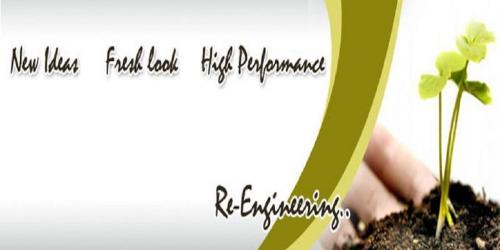Process of Re-Engineering

The re-engineering means that we must take a process and
renew everything that composes it. To do this, we can improve what already
exists from a new idea or simply restarted at zero.
This method aims to optimize the performance of cost,
quality, services and speed. Also, this approach is a complement of total
quality management (concept of total quality). It applies on all hierarchical
levels in order to create a specific output for the market and consumers.
This principle follows several rules that will be presented
in the application section of the method.
The application of the method:
This method is based on two fundamental principles:
Organizations should be viewed as processes, not functions,
divisions, or products.
Organizations must reason intuitively, not inferentially.
According to the first principle, the company must focus on
how the work is to be done and the production to be made. Since business
processes are multifunctional, reengineering involves all hierarchical levels,
which are part of the company's operations.
According to the second principle, the enterprise must
privilege reasoning by intuition either by apparent facts or particular cases
to arrive at new ideas. For this, we must encourage the search for new
solutions that will be determined by intuitive reasoning. This type of
reasoning can be done by issuing new methods, ideas or technologies.
This method is based on several rules. The purpose of these
rules is to change the way things are done to improve performance in terms of
cost, quality, service and speed. These rules are:
·
Grouping tasks
·
Greater decision-making power
·
Operations in a natural order
·
Flexible process
·
Work done in a suitable place
·
Minimum control
·
Unity of the unit responsible for the
client-organization interface
·
Structuring operations according to a hybrid
model
Course note session 11 and 12
Finally, the success of this method is mainly due to a good
understanding of processes, innovative changes and the use of information
technology.
Application examples
In a hospital environment:
The nurses on each floor noticed that they went down too
often to get bandages, machines, blood and tubing kits, blankets, pillows, etc.
Myriam, one of the nurses, gave the idea of taking a room and storing the
necessary materials for their daily work. So they decided to ask the management
to give them a small room on each floor to store their equipment.
In business:
Company leaders noticed that there had been a dozen ammonia
leaks from the refrigeration system of several slaughterhouses. The company has
put in place an emergency and control plan to prevent accidents and leaks.
However, the leaks continue and many employees were hospitalized because they
had been inconvenienced by the ammonia emanation. Here are the changes they
made to have a better emergency plan:
·
Do maintenance of the refrigeration system and
its followed every day
·
Inform employees about hazards and train
employees on ammonia fumes
·
Bring out all employees
·
By department, call employees
·
The factory management is looking for a leak
with qualified people, including one or more refrigeration mechanics with
anti-gas masks
·
Limit damage by closing the department (s) with
plastic curtains and duct tape
·
Clog the leak in the refrigeration system
·
Call CFIA and MAPAQ inspectors
·
Discard contaminated meat and dead animals
The benefits of reengineering
In the first case, the re-engineering has the advantage of
giving the possibility of reducing the costs of the process or processes by
playing with existing concepts and improving them.
Post Your Ad Here
Comments